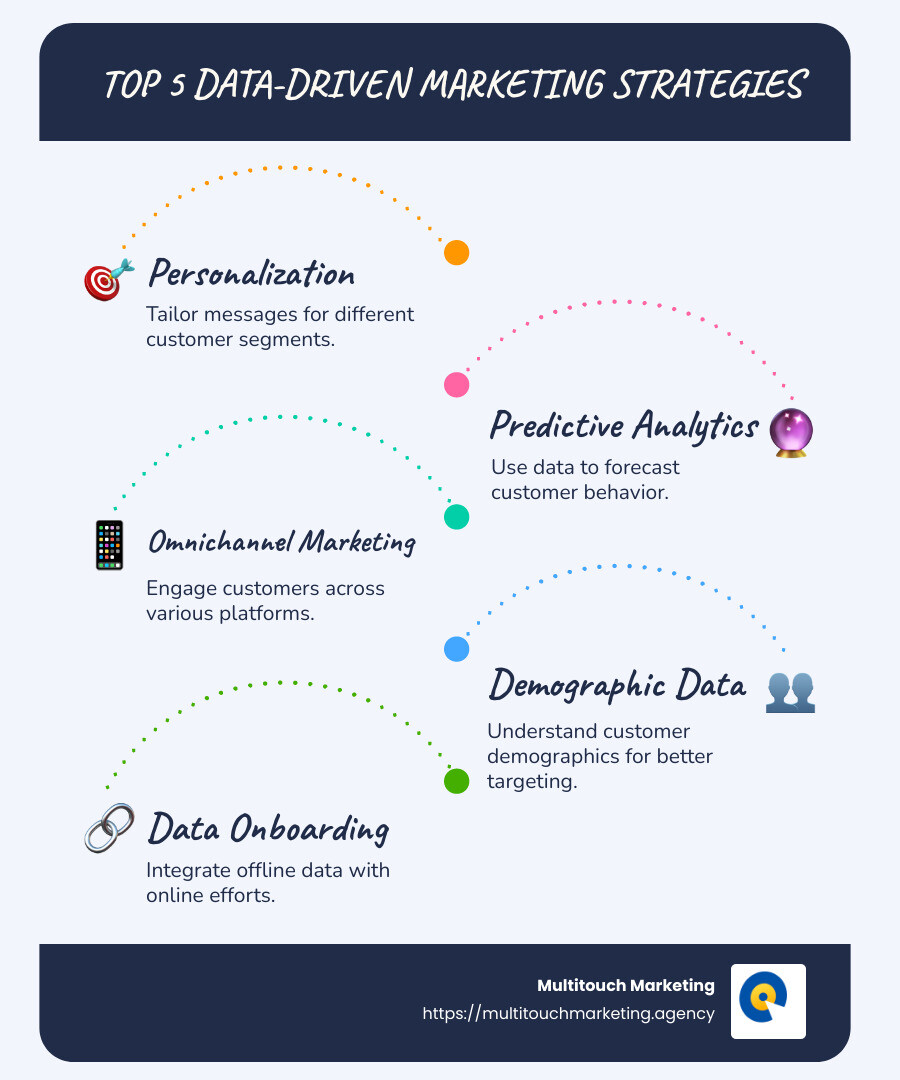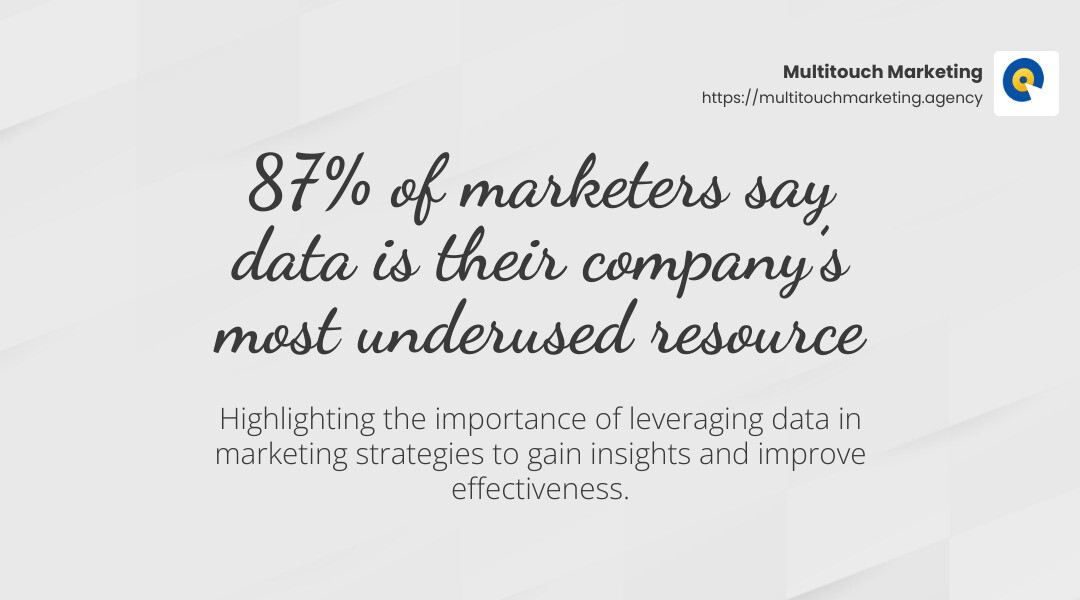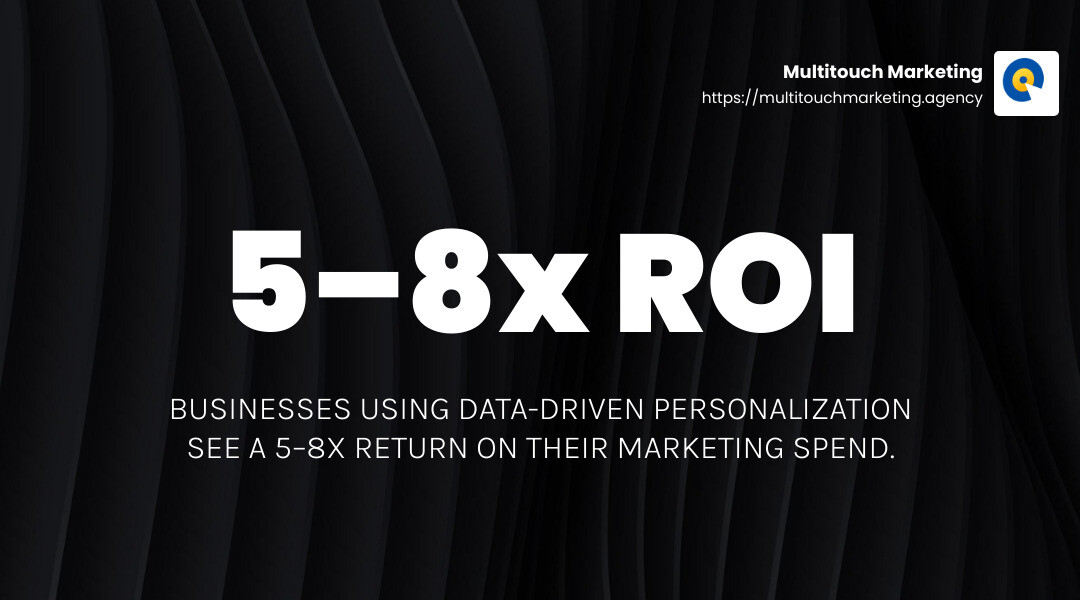Data-driven marketing strategies: Top 5 Proven Benefits
Data-driven marketing strategies are essential for businesses looking to maximize their online visibility and sales. These strategies involve using customer insights to craft marketing campaigns that are more effective and personal. By understanding what your audience wants and how they behave, you can make better decisions and improve your marketing performance. Here’s a quick breakdown of what’s involved:
- Personalization: Create custom messages for different customer segments.
- Predictive Analytics: Use data to forecast customer behavior and trends.
- Omnichannel Marketing: Engage customers across various platforms.
- Demographic Data: Understand customer demographics for better targeting.
- Data Onboarding: Integrate offline customer data with online marketing efforts.
I’m Milton Brown. With over a decade of experience, I have harnessed the power of data-driven marketing strategies to deliver exceptional results for diverse clients, ranging from higher education to healthcare. My expertise in using data to define marketing objectives ensures measurable outcomes and competitive advantages in a dynamic digital marketplace.

Understanding Data-Driven Marketing
Data-Driven Marketing is like having a map and compass for your marketing journey. Instead of guessing where to go, you use data to guide your decisions. Let’s break down the essentials: data collection, data analysis, and customer behavior.
Data Collection
Data collection is your starting point. It’s all about gathering information from various sources to understand your audience better. There are three main types of data:
- First-party data: This is what you collect directly from your customers. Think website analytics, purchase histories, and email interactions. For example, tracking how visitors move through your website can reveal which pages are most engaging.
- Second-party data: This is someone else’s first-party data shared with you. It’s like teaming up with another company to access their customer insights. This can expand your reach without relying on third-party sources.
- Third-party data: Collected by outside companies, this data includes broad demographics and interests. It’s often purchased and helps fill in the gaps about potential customers.
Data Analysis
Once you’ve collected the data, it’s time for data analysis. This step turns raw numbers into actionable insights. You can use tools like Google Analytics or Tableau to visualize data and spot trends.
When analyzing data, always start with a question. For example, if you want to boost engagement on a specific page, ask, “How is that page performing now?” This sets a baseline to measure any changes you make.
Customer Behavior
Understanding customer behavior is key to making your marketing more effective. By examining how customers interact with your brand, you can tailor your strategies to meet their needs.
- Predictive Analytics: This involves using past data to predict future actions. For instance, if a customer frequently buys running shoes, you might predict they’ll respond well to a new sneaker launch.
- Customer Behavior Analysis: This helps you identify loyal customers and understand what keeps them coming back. It can also highlight when customers are about to leave, allowing you to act before they do.
By focusing on data collection, analysis, and understanding customer behavior, you can create a marketing strategy that’s not just informed but also highly effective. This approach helps you deliver personalized messages, improve engagement, and ultimately drive sales.
Next, we’ll explore the Top 5 Data-Driven Marketing Strategies that can help you harness these insights for maximum impact.
Top 5 Data-Driven Marketing Strategies
In data-driven marketing strategies, leveraging data effectively can transform your marketing efforts. Let’s explore five key strategies that stand out: personalization, predictive analytics, omnichannel marketing, demographic data, and data onboarding.
1. Personalization
Personalization is about tailoring your marketing messages to fit individual customer needs. It goes beyond just using a customer’s name in an email. Instead, it involves offering personalized product recommendations, discounts, and more.
2. Predictive Analytics
Predictive analytics uses past data to forecast future customer behaviors. It helps you anticipate what products customers might be interested in next. For instance, if a customer often purchases winter clothing, predictive analytics might suggest marketing winter boots to them as the season approaches.
This strategy not only boosts sales but also improves customer satisfaction by meeting their needs before they even realize them.
3. Omnichannel Marketing
Omnichannel marketing involves creating a seamless customer experience across all channels. Customers today interact with brands on multiple platforms, and consistency is key. Sharing data across these platforms ensures that a customer who views a product on social media can easily find it on your website.
By integrating data from various channels, you can create a unified customer profile, allowing for more cohesive and effective marketing strategies.
4. Demographic Data
Using demographic data helps you understand your audience’s characteristics, such as age, income, and location. This information is crucial for designing targeted campaigns. For instance, if you’re promoting a high-end product, focusing on neighborhoods with higher income levels can improve your campaign’s performance.
Accessing demographic data from sources like the U.S. Census Bureau can provide valuable insights to tailor your marketing efforts effectively.
5. Data Onboarding
Data onboarding is the process of integrating offline data (like in-store purchases) with online data (like website interactions). This creates a comprehensive view of your customer, enabling more personalized marketing.
For example, if a customer frequently buys in-store, you can use this data to offer them exclusive online discounts, encouraging them to explore your digital offerings.
By mastering these data-driven marketing strategies, you can create more personalized, predictive, and effective marketing campaigns. Each strategy is a piece of the puzzle that, when combined, can significantly improve your marketing success.
Next, we’ll explore how to implement these strategies effectively in your marketing efforts.
Implementing Data-Driven Marketing Strategies
Now that we’ve explored key data-driven marketing strategies, it’s time to focus on how to implement them effectively. This involves three critical components: data integration, marketing automation, and campaign optimization.
Data Integration
Data integration is the backbone of any data-driven marketing strategy. It involves combining data from various sources into a single, unified view. This is crucial for creating a seamless customer experience across all platforms.
Imagine a customer who browses your products on social media, visits your website, and then makes a purchase in-store. With integrated data, you can track this entire journey, allowing for more personalized and effective marketing efforts. This approach helps eliminate data silos, ensuring that every team in your organization has access to the same information.
Marketing Automation
Marketing automation is about using technology to streamline marketing tasks. Tools like HubSpot and Mailchimp can automate repetitive tasks such as sending personalized emails, segmenting audiences, and nurturing leads.
Automation not only saves time but also ensures consistent communication with your audience. It allows you to deliver personalized content at the right time, improving engagement and conversion rates. For instance, if a customer abandons their cart, an automated email can remind them to complete their purchase, potentially recovering lost sales.
Campaign Optimization
Once your campaigns are up and running, continuous monitoring and optimization are essential. Use real-time analytics to track key metrics like conversion rates, customer acquisition costs, and ROI. This data will help you understand what’s working and where improvements are needed.
A/B testing is a valuable tool for campaign optimization. By experimenting with different versions of your marketing materials, you can identify the most effective strategies. For example, testing different email subject lines can reveal which one leads to higher open rates.
By focusing on data integration, marketing automation, and campaign optimization, you can effectively implement data-driven marketing strategies that drive results. These components work together to ensure that your marketing efforts are efficient, personalized, and impactful.
Next, let’s dig into the benefits of data-driven marketing and how it can give you a competitive edge.
Benefits of Data-Driven Marketing
Data-driven marketing is more than just a buzzword—it’s a powerful approach that can significantly boost your business. Let’s explore three primary benefits: improved ROI, improved customer experience, and a competitive advantage.
ROI Improvement
When it comes to return on investment (ROI), data-driven marketing is a game changer. By leveraging data, you can focus your resources on the most promising opportunities, ensuring that every dollar spent is optimized for maximum impact. According to McKinsey, businesses that use data-driven personalization can see a 5–8x ROI on their marketing spend.
This targeted approach means you can allocate your budget more efficiently, concentrating on strategies that yield the best results. Whether it’s increasing newsletter signups or boosting engagement with an email campaign, data helps you make informed decisions that drive profitability.
Improved Customer Experience
In today’s competitive market, providing a memorable customer experience is essential. Data-driven marketing allows you to deliver personalized experiences that resonate with your audience. By understanding your customers’ behaviors and preferences, you can tailor your marketing efforts to meet their specific needs.
For instance, Spotify’s “Wrapped” campaign uses customer data to create personalized music summaries, boosting engagement and loyalty. This level of personalization makes customers feel valued, increasing their satisfaction and likelihood to return.
Eighty percent of customers are more likely to engage with brands that offer personalized experiences, and 90 percent find personalization appealing. By tapping into these insights, you can create stronger connections with your audience.
Competitive Advantage
In the world of marketing, staying ahead of the competition is crucial. Real-time data insights provide a strategic edge, allowing you to respond quickly to market changes and customer behavior. This agility enables continuous optimization of your marketing efforts, ensuring you remain relevant and effective.
Tom Benton, CEO of the Data and Marketing Association, highlights the potential of data to deliver 1-to-1 customer experiences at scale. For businesses, this means the ability to cater to individual customer needs, even with a large audience. By leveraging data adeptly, you can create personalized interactions that rival those of smaller, more niche companies.
By embracing data-driven marketing, you can improve your ROI, improve customer experiences, and gain a competitive advantage. These benefits not only boost your bottom line but also position your brand as a leader in the industry.
Next, we’ll address some frequently asked questions about data-driven marketing strategies to deepen your understanding of this transformative approach.
Frequently Asked Questions about Data-Driven Marketing Strategies
What is a data-driven approach to marketing?
A data-driven approach to marketing involves making decisions based on data analysis rather than intuition or guesswork. It’s all about understanding customer preferences through big data analysis. By analyzing facts and metrics, marketers can gain insights into what customers want and how they behave. This approach helps businesses tailor their marketing strategies to meet customer needs effectively.
For example, companies can use data to determine which products are most popular among certain demographics or which marketing channels yield the highest engagement. This information allows for more informed decision-making, ensuring that marketing efforts are both efficient and effective.
What are data-driven strategies?
Data-driven strategies are marketing tactics that rely on concrete data to guide decision-making. These strategies use metrics and analytics to identify trends and patterns in customer behavior. By doing so, businesses can create targeted campaigns that resonate with their audience.
One key aspect of data-driven strategies is the ability to predict future customer actions. Predictive analytics, for instance, can help marketers anticipate customer needs and tailor their messaging accordingly. This proactive approach ensures that marketing efforts are not only timely but also relevant.
What is a data-driven marketing example?
An excellent example of data-driven marketing in action is seen in the ecommerce sector. Imagine a customer browsing an online store for running shoes. The store can use data to send personalized alerts about special offers or new arrivals based on the customer’s browsing history and preferences.
This level of personalization is possible through the analysis of customer data, such as past purchases or search behavior. By leveraging this information, ecommerce businesses can create a seamless shopping experience that encourages repeat purchases and builds customer loyalty.
In summary, data-driven marketing strategies empower businesses to make informed decisions, deliver personalized experiences, and drive better results. By understanding customer preferences and utilizing big data analysis, companies can stay ahead in the competitive marketing landscape.
Need Help?
At Multitouch Marketing, we understand the power of data-driven marketing strategies. Our expertise in PPC advertising helps businesses harness data to drive their marketing campaigns. By focusing on facts and metrics, we guide our clients toward making smarter decisions and achieving better results.
PPC advertising is a complex and ever-changing field. But with our expert guidance, businesses can steer its intricacies with confidence. We specialize in creating effective PPC campaigns that are informed by data, ensuring that every click counts.
Our approach is all about using data to make informed decisions. We analyze customer behavior, identify trends, and tailor campaigns to meet specific needs. This means that our clients’ marketing efforts are not just efficient, but also effective.
With locations in Raleigh, NC, Multitouch Marketing is ready to help you master the art of data-driven marketing. Our team is dedicated to providing the support and expertise you need to succeed in today’s competitive landscape.
Ready to take your marketing to the next level? Explore our services and find how we can help you achieve your marketing goals.



